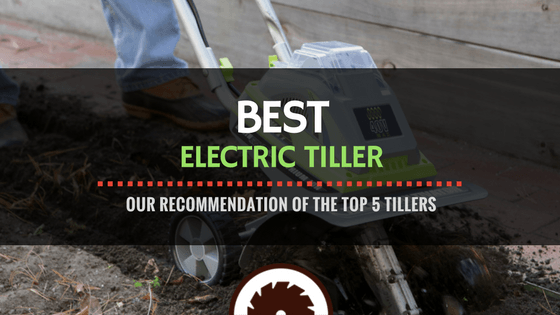
Best Electric Tiller Review: Our Recommendation of the Top 5 Tillers
OUR PICK
Too Lazy to Read? Discover our top choice now!
Not a big fan of long reviews? Here's the bottom line: The best Electric Tiller in the market today is the Earthwise TC70001. Its compact design and low maintenance raise it high above the competition, while the fact that it is eco-friendly makes it an excellent option for large yards!
Unless you are still a young muscle bound stud who wants to show off or you are preparing for a prize fight, there really isn’t any reason to continue using a shovel or broad-fork to till your garden. Our Best Electric Tiller of 2019 Review guide will help you sort through the best features to fit your needs. Here are five of the best electric tillers we will take a look at.
Table of Content
Rating | Product |
|---|---|
 Best | |
   | |
   | |
   | |
   |
How to Choose The Best Electric Tiller in 2019
Choosing the right electric tiller for you is going to be based on several different factors: the volume of work you plan to do, how you use it, your physical strength and, of course, your budget. In order to help you make an informed choice, let’s break down what an electric tiller is, does and how to use it.
What is an electric tiller?
In general, a rotary tiller is a mechanical tool which is used to loosen soil in your garden for planting. An electric tiller makes use of an electric motor to power rotating blades that slide through the soil and dig it up.
There are advantages and disadvantages of various types of tiller models, which distinguish one tiller from another, let’s take a closer look.
After watching the video, you will probably be convinced that tilling by hand is not the way you want to go.
What are the advantages or benefits of an electric tiller?
The advantage of an electric tiller is that it reduces or gets rid of the pain in your back from muscling around a spade or broadfork all day. Rather than using the power of your own muscles to break up the soil, a tiller uses mechanical power. The right tiller can also be used to cultivate and weed your garden, which saves you some more backbreaking labor.
As opposed to heavier, gas powered tillers, electric tillers tend to have smaller tines which break the soil up into smaller clumps which makes it easier to rake as you sow or plant. The tighter tines also make them more suitable for cultivating and weeding as well.
Things to look for in an Electric Tiller
When it comes to choosing the right electric tiller for you, comparing standard and special features of individual models is helpful. Below, is a list of features and how they might add value to the tool and justify spending your hard earned money. Take into consideration:
What's the best way to use Electric Tillers?
Since planting and nourishing seeds is nearly impossible to accomplish in hard ground, you have to break up the soil so that it will breathe and allow tender sprouts to come through the soil. Electric tillers can accomplish that in a small, home garden by performing various functions:
Electric Tiller vs Gas Tiller
One great thing about electric cultivators is their ease of use. They’re also less expensive, lighter, quieter and much easier to maintain than their gas-powered cousins, while still delivering more than enough power for small projects.
Getting a gas unit started can often wear you out before you even start work, but a gas tiller is more apt to have the power to slice through more compact soil and is better for breaking sod. The tines on gas powered units are usually larger and built for heavier work, consequently, that also makes them a little too aggressive for cultivating and weeding.
For those who are more environmentally conscious, one of the advantages of an electric tiller is that it is more green friendly as the video points out below.
Top Rated Electric Tillers On The Market
The compact design of the Earthwise TC70001 electric tiller makes it easier to maneuver around your garden as well and also makes it easier to store when not in use. It can break up hard soil, cultivate and weed. It is eco-friendly, hassle free and low maintenance.
The compact design is attractive, though it is a bit heavier than other models in our electric tillers review, and requires you to plant your rows further apart to accommodate its width for cultivating and weeding. This tiller specializes in breaking ground more than for cultivating or weeding.
Specs:
PROS
CONS
Check out our in-depth review:
Earthwise TC70001 11-Inch 8.5-Amp Corded Electric Tiller/Cultivator
Versatility for performing all three functions of a tiller make the GreenWorks 27072 a decent choice to consider. It has adjustable width and depth and doesn’t give away too much in power. It has a light, compact design as well.
It is pretty light and has a compact design for easy storage and transport. The width adjustment is a good feature for weeding and cultivating, but the 5-inch depth lacks a little bit for breaking new ground.
It is probably underpowered for more compact soils, but its budget price makes it pretty tempting to buy.
Specs:
PROS
CONS
The lightweight, compact design of this unit with adjustable depth control and effortless operation while allowing for full control gives it an edge over gas powered tillers, though it is the closest thing to a gas tiller among electric powered models.
The extra muscle in the motor of the Sun Joe TJ603E is one of the celebrated features of this model. Because of the power in the compact design and weight of this unit, it is a better choice among electric tillers for breaking new ground.
The tine width allows you to make fewer passes while tilling, but you sacrifice when it comes to cultivating and weeding. This unit might be too aggressive on tender plants too.
Specs:
PROS
CONS
Related Articles:
How does the Sun Joe TJ603E compare to the TJ604E?
Power and performance backed by a trusted name in lawn and garden equipment are great selling points for the Troy-Bilt TB154E Garden Cultivator.
Its compact design and wheels to offset its weight makes it easy to maneuver in small places. The three-way tine design gives it an edge on digging. This Troy Bilt electric tiller is probably the most versatile and dependable of the five tillers we reviewed.
Though it is heavier than most of the models, its wheels make it workable. Its width adjustment makes it adaptable to various uses and its three-way tines break up soil better.
Specs:
PROS
CONS
No one can deny that the Mantis 7250-00-02 Electric Tiller/Cultivator can dig. Its variable three-speed feature sets it apart from most electric tillers and allows it to work as a cultivator as well as a tiller.
Its depth adjustment also helps make it a garden tool to keep an eye on. If it had more power, this would be the unit of choice. The variable speed and reversible tines are features that make this a solid consideration. It is light, compact and will dig deep.
The question is whether or not it will perform the heavy duty work of breaking compact soil. It will break the bank, because it costs more than twice as much as the other units reviewed.
Specs:
PROS
CONS
Conclusion
The electric tiller which best fits your needs will come down to a matter of how you intend to use it, how much work you have to do, your physical strength and stamina, and whether it fits into your budget. Using our best electric tiller reviews, you can make a more informed decision. For us, the Troy-Bilt TB154E gets the nod.
The Troy-Bilt tiller/cultivator, though a little bit underpowered for breaking through compact soil can perform all three functions of tilling, cultivating and weeding. Its tine configuration is what really makes the difference. The three-way tine design, unique to this unit, does a more thorough job of breaking up the soil. The width adjustment all the way down to 6” makes it fit between narrower garden rows. Its tine speed is not too aggressive for tender plants either. Keeping those features in mind, it also comes at a decent price and is backed by a solid brand name.
Regardless of which unit you choose, don’t break your back manually tilling, cultivating and weeding your garden. Make use of mechanical power rather than muscle power and get your hands on an electric garden tiller today.










